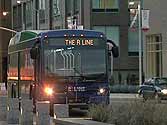Mobile digital television broadcasting joined forces with public transit on April 13, 2009, as the City of Raleigh, WRAL and the CBC New Media Group launched the first public deployment of mobile digital TV in a Capital Area Transit bus.

The first deployment of mobile digital television is on Raleigh’s downtown R Line bus, which commuters can for free. |
The new venture delivers real-time digital television and interactive data to CAT buses. CAT bus passengers will be able to view WRAL’s local and syndicated programming throughout the day. Additionally, the screens will offer CAT passengers city news, real-time schedules, route specific updates and other useful information on the digital screens that are strategically placed inside buses.
“Once again, Raleigh is unveiling a technology first,” said Mayor Charles Meeker. “We are proud to be the pilot to offer mobile digital television to the riders of the Downtown Circulator.
“We salute WRAL for being pioneers in mobile digital television as they were in high definition television,” he said. “We look forward to the day when all of Raleigh’s CAT buses will offer this means of information and relaxation. It’s just another reason to take a CAT bus wherever you go.”
“Mobile DTV broadcasting is a major part of our future and we are excited to partner with the City of Raleigh as we enter a new era of technology,” said Capitol Broadcasting CEO and President James F. Goodmon. “Mobile DTV broadcasting enables WRAL to better serve our viewers, communities and advertisers by providing a strong combination of anywhere access, two-way communication and mobility.”
One bus featured MDTV as of Tuesday. The schedule is to install the feature on four CAT buses for the pilot period, which runs through August 2009. In the second phase of the program, it is planned to equip 20 CAT buses with MDTV from September 2009 through August 2010.
Cutting-edge technology for the mobile DTV system is provided by co-developers LG Electronics, Inc. and Harris Corporation. LG Electronics will provide mobile DTV receivers, flat screen monitors and project development and support. Harris will provide mobile transmission equipment, the digital signage systems and development and support services.
Two regional companies also will support the venture. Microspace Communications Corporation will provide wireless networking and digital signage system management. Digital Recorders, Inc. (DRI) will provide integration of the communications systems on the CAT buses.
Mobile DTV based on the emerging ATSC Mobile DTV standard, allows broadcasters to allocate a portion of their digital channel capacity to reach viewers outside the home. The Raleigh project demonstrates the viability of mobile DTV as broadcasters explore ways to tap the promising market for mobile television.
Thanks to WRAL.com for this capcom story & photo.